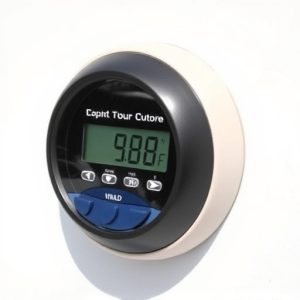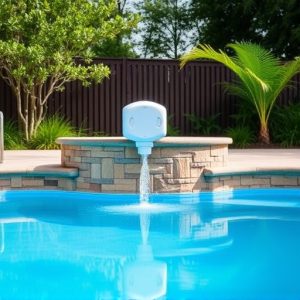Inground Pool Safety: Protecting Your Family with Swimming Pool Alarms
Swimming pool alarms are essential safety devices for inground pools, acting as a deterrent against …….
Swimming pool alarms are essential safety devices for inground pools, acting as a deterrent against unauthorized access and potential drowning incidents. These alarms sound an audible alert when they detect movement around the pool area, playing a critical role in safeguarding lives, especially when direct supervision is absent. For enhanced safety, they should be part of a comprehensive strategy that includes secure fencing and consistent adult oversight. Homeowners must choose reliable alarm systems compliant with local safety standards and perform regular maintenance and testing to ensure readiness for emergencies. Swimming pool alarms come in various types, including surface wave alarms and underwater motion sensor alarms, and for added security, wireless alarms that offer remote monitoring via smartphones are available. It is crucial to select a system that fits the specific needs of an inground pool for optimal performance. The integration of these alarms with home automation systems further strengthens pool safety measures, contributing to a safer aquatic environment and potentially preventing tragic accidents.
When the sun’s rays reflect off the shimmering surface of an inground pool, families flock to its inviting depths for respite and recreation. Amidst the laughter and splashes, safety becomes paramount. This article delves into the critical aspects of inground pool safety, emphasizing the role of swimming pool alarms as a vital safeguard against accidents. From perimeter alarms that guard against unauthorized access to wristband alarms that monitor swimmers’ movements, we explore a spectrum of alarm systems designed for inground pools. Additionally, we provide guidance on installation and maintenance, ensuring your safety measures function at their best. Beyond these technological defenses, we discuss essential safety measures, including physical barriers, vigilant supervision, swimming lessons, emergency preparedness, and understanding state and local regulations to create a comprehensive safety plan for your inground pool.
Understanding the Importance of Inground Pool Safety
Swimming pool alarms are critical components of inground pool safety, serving as a first line of defense against drowning incidents. These alarms are designed to detect unauthorized or accidental access to the pool and can alert homeowners and caretakers with an audible sound upon activation. A robust safety regimen should include installing such alarms around the perimeter of inground pools, especially when the pool is not actively supervised. The U.S. Consumer Product Safety Commission (CPSC) reports that drowning remains a leading cause of unintentional death for children aged 1 to 3 years old. This stark statistic underscores the need for vigilance and proactive safety measures. Swimming pool alarms for inground pools are particularly effective when combined with other safety strategies, such as secure fencing and adult supervision. By integrating these alarms into your safety protocol, homeowners can significantly reduce the risk of tragic accidents involving inground pools. It is imperative to select a reliable alarm system, one that meets local safety regulations and has a proven track record of dependability. Regular maintenance and testing of these systems are equally important to ensure they function optimally when needed most. In doing so, homeowners can provide an additional layer of protection for swimmers of all ages, promoting a safer environment for recreational aquatic activities.
Types of Swimming Pool Alarms for Inground Pools
When prioritizing safety measures for inground pools, installing a reliable swimming pool alarm system is paramount. These alarms serve as an early warning device that can detect unauthorized access or potential drowning incidents by alerting homeowners and caretakers to movements in and around the pool area. There are several types of swimming pool alarms designed specifically for inground pools, each with its unique features and functionalities.
The first category includes surface wave pool alarms that detect disturbances on the water’s surface, ideal for preventing unauthorized or accidental access to the pool. These systems can be highly sensitive, distinguishing between human movements and environmental factors like wind or debris. Another type is the underwater motion sensor alarm, which monitors for any movement within the pool, ensuring that even if someone gains access to the water, their actions will not go undetected. For inground pool owners who prefer a more sophisticated approach, there are also state-of-the-art wireless alarms with remote monitoring capabilities, allowing users to receive real-time notifications on their smartphones or other devices when activity is detected. These advanced systems often integrate with home automation systems for comprehensive security coverage. In all cases, it’s crucial to select a swimming pool alarm that aligns with the specific needs and layout of an inground pool to ensure maximum safety and effectiveness. Regular maintenance and testing of these alarms are essential to guarantee their functionality and reliability at all times.
– Perimeter Alarm Systems
When prioritizing safety measures around an inground pool, one of the most effective and reliable devices to consider are perimeter alarm systems specifically designed for swimming pool alarms. These sophisticated systems are engineered to detect unauthorized access or accidental falls into the water by sensing disturbances in the water’s surface. Upon activation, they sound a loud audible alarm, alerting homeowners or lifeguards immediately, which is crucial for timely intervention and preventing potential drowning incidents. The installation process typically involves placing sensors around the perimeter of the pool, ensuring seamless coverage and continuous monitoring. By integrating these systems into your inground pool safety protocols, you can significantly enhance the protection of swimmers, particularly children who are at a higher risk of wandering unsupervised near pool areas.
Selecting the right swimming pool alarms for inground pools is essential. Homeowners should look for systems that offer both surface movement and water immersion detection capabilities to accommodate different safety needs. Additionally, these alarms should be user-friendly, with clear instructions for installation and maintenance. They must also comply with local regulations and standards for pool safety. By choosing a reputable brand and model that meets these criteria, you can rely on these perimeter alarm systems to provide an additional layer of defense against pool-related accidents, complementing other safety measures such as physical barriers and active supervision.
– Wristband and Wearable Alarms
When prioritizing the safety of individuals enjoying an inground pool, the implementation of wristband and wearable alarms is a critical measure. These alarms are specifically designed to detect when a wearer enters the water, providing a timely alert that can be crucial for preventing accidents. Unlike traditional floating pool alarms, these devices offer a more personalized approach to monitoring activity in and around the pool. They are particularly beneficial for homes with young children or individuals with mobility issues who might otherwise be at risk of unsupervised access to the water. For instance, swimming pool alarms for inground pools can be set up to notify caregivers immediately upon contact with the water, ensuring a rapid response time and potentially saving lives. These wearable alarms are also user-friendly, equipped with waterproof technology that is both reliable and easy to use. They offer peace of mind without compromising on convenience, making them an indispensable tool for maintaining a safe swimming environment. Additionally, they complement the physical barriers like fences and gates around the pool area, providing a layered approach to safety that is recommended by safety experts and organizations dedicated to preventing drowning incidents.


